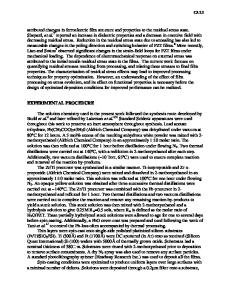Effect of gradients in multi-axial stress states on residual stress measurements with x-rays
- PDF / 719,525 Bytes
- 10 Pages / 603.28 x 788 pts Page_size
- 51 Downloads / 370 Views
I.
INTRODUCTION
S3
THE determination
of surface residual stresses in polycrystalline materials by X-ray methods is well established) '2 Traditional methods assume a biaxial stress state that is uniform in the surface layers penetrated by the X-ray beam. This assumption is based on the conception that this penetration depth is too low to be affected by the stresses in the third dimension. These methods predict a linear variation of interplanar spacing "d" with "sin2~Y', with a slope that is proportional to the stress in the measurement direction ( S . ) ; here 0 is the angle between the normal to the diffracting planes (L3) and the surface normal of the specimen ($3), as shown in Figure 1. If the components of the (assumed) biaxial stress tensor exhibit steep gradients in the volume sampled by the X-ray beam, curvature occurs in the "d" vs sin20 plot. The slope of a least-square fit to such data yields the stress in the (S~) direction, averaged over the depth of penetration. 3 The assumption in these traditional methods, that stress components in the direction of the surface normal ($3) are negligible in the volume sampled by the X-ray beam, has been disproved in several recent studies. 4'5 Stress components of appreciable magnitude in this direction have been detected in the surface layers of materials, created in various ways. Recent theory, as well as experiments, show that if stresses (Or13,or23) in the direction of the surface normal ($3) are present, "splitting" of the "d" vs sin20 data results; that is, "d" v s sin20 plots have opposite curvature for negative and positive 0. Analysis of such data is described in detail by D611e6 (see also Reference 4 for an example of the use of this analysis). If, however, only normal stress (o'33) is present in the direction of the surface normal and shear components are negligible, curvature occurs in the "d" vs sinZ0 data and there is no "0-splitting". The degree of such curvature depends on the steepness of the gradient in o'33. (Since cr33 is a stress normal to the surface, it is zero, by definition at the surface. Thus, it has to exhibit a gradient in the surface layers.) D611e, James, and Cohen 5 have shown how to estimate the gradient using this curvature. It will be shown in this paper that, even for very small curvature in the "d" v s sin20 data, analysis with the biaxial assumption causes an appreciable error in the calculated surface stress. Methods are proposed that provide for the determination of the complete stress tensor in the surface layers in the ab-
-
-~
13
_L2
Fig. 1 --Definition of the angles 9 and 0 and orientation of the laboratory system L~ with respect to the sample system S~ and the measurement direction S~.
sence of 0-splitting, i.e., when cq3, cr23are negligible. These methods are tested here by computer simulation. II.
THEORY
The orthogonal coordinate systems used in the following discussion are shown in Figure I. The specimen axes are defined such that $1 and $2 are in the surface of the sample. The laboratory system, in which diff
Data Loading...











